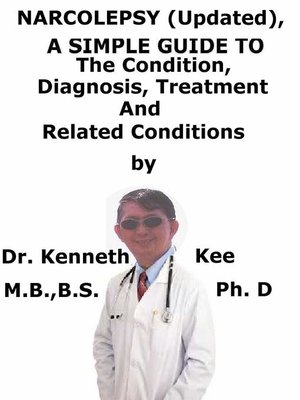Narcolepsy (Updated), a Simple Guide to the Condition, Diagnosis, Treatment and Related Conditions
ebook
By Kenneth Kee

Sign up to save your library
With an OverDrive account, you can save your favorite libraries for at-a-glance information about availability. Find out more about OverDrive accounts.
Find this title in Libby, the library reading app by OverDrive.



Search for a digital library with this title
Title found at these libraries:
| Loading... |
This book describes Narcolepsy (Updated), Diagnosis and Treatment and Related Diseases
Narcolepsy causes periods of extreme daytime sleepiness.
The disorder also may cause muscle weakness.
Most people who have narcolepsy have low levels of hypocretin.
This is a chemical in the brain that helps promote waking
Narcolepsy is believed to be due to the auto-immune disease
The immune system mistakenly attacks the body's tissues.
Low levels of histamine promote sleepiness.
Often the brain show evidence of mental cloudiness
The four main symptoms of Narcolepsy are cataplexy,
Extreme daytime sleepiness, hallucinations and sleep paralysis
Narcoleptics may have episodes where they fall asleep suddenly
Sleep may also happen in the middle of talking or another activity
Maintain a regular sleep schedule in a warmed environment
Avoid alcohol, caffeine-containing beverages and distractions
Avoid large, heavy meals just before sleeping
Take antidepressants and stimulants while working
-An original poem by Kenneth Kee
Narcolepsy can affect nearly every part of a person's life.
It is dangerous since the person can have excessive sleepiness or a sleep attack at any time of the day, in the middle of any activity such as eating, walking or driving.
Driving a vehicle with untreated narcolepsy can be very dangerous and some countries even have laws against it.
Many people with narcolepsy do not recognize they have the sleep disorder.
About 1 in 2,000 people have some type of narcolepsy.
Narcolepsy may happen in some families, but most patients have no genetic inheritance.
I have a patient who had narcolepsy.
Once in a while when he consulted me, he would go into trance for a few minutes before waking up again.
He was treated by me for at least 10 years without a problem until one day he went into a narcolepsy episode while riding on his scooter and crashed into a car.
Happily his injuries were not severe and he recovered.
However he decided since then not to ride a scooter and took a bus instead.
He is still working in spite of his occasional narcoleptic episodes.
Narcolepsy is a neurological disorder featured by sleeping at inappropriate times with intense feeling of sleepiness which ironically results in normal number of hours of sleep.
Narcolepsy is a disorder that induces periods of excessive, uncontrollable daytime sleepiness.
They may also suddenly fall asleep at any stage, during any form of activity.
The disorder also may produce muscle weakness.
It is not caused by mental illness or psychological disorders.
Narcolepsy is a chronic brain disorder that affects and produces poor control of sleep-wake cycles.
People with narcolepsy have periods of extreme daytime sleepiness and sudden, irresistible bouts of sleep that can happen at any time.
These sleep attacks normally persist a few seconds to several minutes.
Narcolepsy can greatly involve daily activities.
People may unwittingly fall asleep:
a. While at work or at school,
b. When having a conversation,
c. Playing a game,
d. Eating a meal,
e. When driving or operating other types of machinery.
Besides daytime sleepiness, other major symptoms may be:
1. Cataplexy (a sudden loss of voluntary muscle tone while awake that makes a person go limp),
2. Vivid dream-like images or hallucinations,
3. Total paralysis just before falling asleep or just after waking-up.
People with narcolepsy do not use up a substantially greater part of their time asleep during a 24-hour period...






